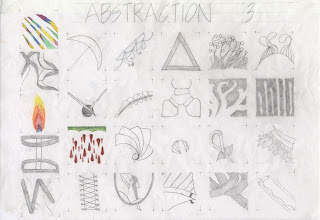This first abstraction started biological. I zoomed in to capture the intricacies of the orange lily; the cellulose stalks of the stem, the shift in color from green to yellow to orange in an array of orientations, the outward curl of the set of streamline petals, and the veining of the second set of ruffled petals. Examining the flower so closely sparked other conceptual images related to its components.
The first images I contrived were rather immature; the cartoonish shapes, the reliance on geometry, and some pretty garish colors. But the more I tinkered and let my hand flow I started to delve into a more abstract world. I contended with the initial biases of abstract thinking; what is the use of exercises in the abstract? After I labored over this thought I found that abstract thinking is one of the major foundations of design. In order to design an inspired space, one needs to practice the art of abstraction and meld it with function.
I built more abstract concepts off of abstraction 2. I learned that I didn't need to make every square a piece of art. The goal was to break functional aspects of the object down to incremental, pictorial abstract thoughts from which to build a design.



No comments:
Post a Comment